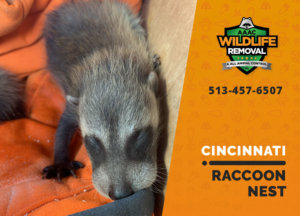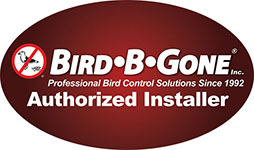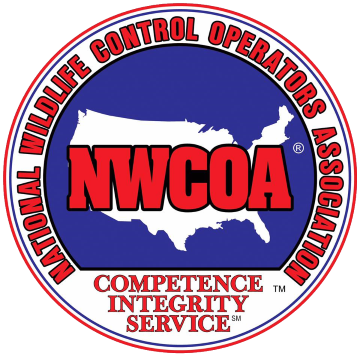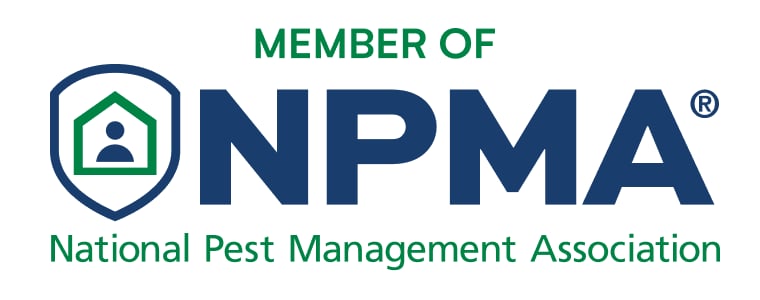
Raccoons and Homes
Alright, let’s get down to the nitty-gritty of why raccoons think your attic is the perfect spot for their cozy nest. Raccoons are resourceful little critters. Outside, they’ll gather long grasses, leaves, and anything soft to create a snug haven. Inside your home, though, they hit the jackpot with insulation, old clothes, and any other soft materials they can scavenge.
So, you’re on a mission to find this nest. First things first, stay calm. Grab a flashlight and listen for those tiny rustles and mewling noises. Raccoon kits make a distinctive whine that can lead you straight to their hidey-hole. It’s like playing a very high-stakes game of hide-and-seek. You can’t merely trap the mother raccoon and leave the babies in the house to starve. They must be removed by hand. Whenever you have a raccoon nest in the attic, it is best to do the following.
But here’s the kicker – most raccoons setting up shop in your attic are mama raccoons looking for a safe space to raise their young. They’re not picky about where they live, as long as it’s safe and sheltered. So, if you hear those little mews, it’s safe to assume you’ve got a family up there. And trust me, handling a raccoon nest isn’t something you want to DIY. That’s where we, the pros at AAAC Wildlife Removal of Cincinnati, come in. We’ve got the experience, the tools, and the know-how to safely and humanely remove these unwelcome guests and secure your home against future invasions.
Health Risks of Raccoon Infestations
Let’s talk about the elephant – or should I say, raccoon – in the room: health risks. Having a family of raccoons nesting in your attic isn’t just a noisy nuisance; it’s a potential health hazard. These cute critters can carry a host of diseases that aren’t so cute. We’re talking raccoon roundworm, leptospirosis, and salmonella – just to name a few.
Raccoon roundworm, for instance, is a particularly nasty parasite that can be found in raccoon droppings. If accidentally ingested or inhaled, it can cause serious health issues in humans and pets. And let’s not forget the risks of raccoon bites and scratches, which can lead to infections or even rabies. Beyond diseases, raccoon droppings and urine can cause allergies and respiratory problems, especially if you or your family members are sensitive to such allergens. The bottom line? Sharing your home with raccoons is a health risk you don’t want to take. That’s another solid reason to call AAAC Wildlife Removal of Cincinnati – we handle the dirty work, so you don’t have to.
Exclusion Methods for Raccoons
Now that we’ve covered the why, let’s dive into the how. Raccoon exclusion is all about preventing these masked bandits from re-entering your home once they’ve been evicted. Think of it as adding an extra layer of security to your fortress. There are several effective exclusion techniques to consider, each designed to keep raccoons out while being humane and non-lethal.
First up, one-way doors. These nifty devices allow raccoons to leave your attic but not return. It’s like giving them a one-way ticket out of town. Next, heavy-duty mesh and hardware cloth are great for sealing off entry points. Raccoons are persistent, but they’re no match for a well-secured vent or chimney. Speaking of chimneys, chimney caps are a must. They keep raccoons, and other wildlife, from using your chimney as a gateway into your home.
But here’s the catch – exclusion isn’t a one-size-fits-all solution. It requires a keen eye to identify all potential entry points and the expertise to seal them effectively. That’s why it’s best left to professionals like us at AAAC Wildlife Removal of Cincinnati. We ensure every nook and cranny is raccoon-proof, giving you peace of mind that your attic won’t turn into a raccoon motel again.
DIY vs. Professional Raccoon Removal
Alright, let’s address the burning question: should you tackle raccoon removal yourself, or is it best to call in the pros? DIY raccoon removal might seem like a cost-saving venture, but it comes with significant risks and challenges. First, raccoons can be aggressive, especially when protecting their young. A startled or cornered raccoon might bite or scratch, posing a danger to you and your family.
DIY methods like setting traps or using repellents can be tricky and often ineffective. Traps need to be placed correctly and checked frequently, and once you’ve caught a raccoon, you have to deal with the daunting task of relocating it safely and legally. Repellents, on the other hand, can sometimes work temporarily but rarely provide a long-term solution. Plus, there’s the issue of ensuring you’ve found and removed all the kits, not just the mother.
On the flip side, hiring professionals like AAAC Wildlife Removal of Cincinnati brings a host of benefits. We have the training, experience, and tools to remove raccoons safely and humanely. Our experts can assess the situation, identify all entry points, and implement comprehensive exclusion techniques to prevent future infestations. Plus, we handle the cleanup, sanitization, and repairs, ensuring your home is safe and secure. When it comes to raccoon removal, going pro is the way to go.

Raccoon Nest Removal Process
So, what does the raccoon nest removal process actually look like? Let’s break it down. The first step is an initial assessment. Our team at AAAC Wildlife Removal of Cincinnati starts by thoroughly inspecting your attic and surrounding areas to locate the nest and identify all entry points. We look for signs of raccoon activity, such as droppings, nesting materials, and those telltale noises.
Once we’ve pinpointed the nest, it’s time for the removal. Handling a raccoon nest, especially one with young kits, requires a gentle touch and expert knowledge. We use safe, humane methods to remove the mother and her babies, ensuring they’re reunited and relocated to a suitable habitat. This process is done with the utmost care to minimize stress and harm to the animals.
After the raccoons are safely out, we move on to the cleanup. Raccoon nests can be messy, leaving behind droppings, urine, and nesting debris that can harbor diseases. Our team sanitizes the area thoroughly, removing any hazardous materials and odors. Finally, we repair any damage caused by the raccoons and seal up entry points to prevent future invasions. This comprehensive approach ensures your home is raccoon-free and stays that way.
Preventing Future Infestations
Alright, you’ve successfully evicted the raccoons and cleaned up the mess – now what? It’s time to raccoon-proof your home to prevent any future furry squatters. Prevention is key, and a little effort now can save you a lot of hassle down the road.
Home Maintenance Tips: Start by inspecting your home for potential entry points. Raccoons are adept climbers and can squeeze through surprisingly small gaps. Check your roof, eaves, vents, and chimney for any openings. Securely seal these areas with heavy-duty materials like hardware cloth or steel mesh. Make sure to install chimney caps to prevent raccoons from using your chimney as a convenient entrance.
Next, take a look at your yard. Trim tree branches that hang close to your roof – raccoons can use them as bridges to access your attic. Keep your yard tidy and secure trash bins with tight-fitting lids to eliminate food sources that might attract raccoons. If you have outdoor pet food, bring it inside at night.
Seasonal Considerations: Different seasons bring different challenges. In the fall, raccoons look for warm places to hunker down for the winter, making your attic an attractive option. Conduct seasonal checks and maintenance to ensure your home remains secure throughout the year. With these proactive steps, you’ll make your home a less appealing target for raccoons and other wildlife.
Understanding Raccoon Behavior
To outsmart a raccoon, you’ve got to think like a raccoon – or at least understand their behavior. These nocturnal critters are incredibly intelligent and resourceful, which makes them both fascinating and challenging to deal with.
Nesting Habits: Female raccoons are particularly drawn to attics during their nesting season, which typically runs from late winter to early summer. They seek out safe, quiet spaces to give birth and raise their young. Understanding this nesting behavior helps in identifying the best times to check for and address potential infestations.
Raccoon Activity Patterns: Raccoons are most active at night, foraging for food and exploring their surroundings. If you hear noises in your attic during the night, there’s a good chance it’s a raccoon. During the day, they tend to rest, which is why daytime inspections can be less effective. Knowing their activity patterns can help you time your inspections and interventions more effectively.
Problem-Solving Skills: Raccoons are known for their problem-solving abilities. They can open containers, navigate obstacles, and even remember solutions to problems they encountered previously. This intelligence makes them adept at finding and exploiting entry points into your home. By understanding their capabilities, you can better prepare and reinforce your home against their clever antics.
Understanding these aspects of raccoon behavior not only helps in dealing with current infestations but also in preventing future ones. It’s all about staying one step ahead of these crafty critters, and with the right knowledge and tools, you can do just that.
Common Myths About Raccoons
Let’s bust some myths about our masked visitors. Raccoons have a bit of a bad rap, and not all of it is deserved. Understanding the truth behind these common misconceptions can help you handle an infestation more effectively and humanely.
Raccoons are aggressive and dangerous– While raccoons can become defensive if they feel threatened, they are generally not aggressive towards humans. Most raccoon attacks happen when the animal is cornered or protecting its young. If you encounter a raccoon, give it space, and it will likely retreat on its own.
Raccoons only live in rural areas– Think again! Raccoons are incredibly adaptable and have no problem thriving in urban environments. Cities offer abundant food sources and nesting sites, making urban areas just as attractive as rural ones. That’s why you might find them in your attic, even if you live in the heart of the city.
Raccoons are dirty animals– While they can make a mess in your attic, raccoons are quite clean in their natural habits. They often wash their food before eating it and keep their dens relatively clean. The mess they leave behind in your home is more about the difficulty of living indoors rather than their natural behavior.
Raccoons are solitary animals.– While male raccoons are typically solitary, females, especially those with young, often stay in family groups. Understanding this social behavior is crucial when dealing with an attic infestation, as there’s likely more than one raccoon in your home.
Case Studies and Testimonials
Nothing beats a good story, right? Here are a couple of real-life tales from our adventures in raccoon removal, showcasing our expertise and commitment to humane practices.
The Suburban Invasion
Mrs. Thompson, a homeowner in suburban Cincinnati, called us in a panic after hearing strange noises in her attic. Upon inspection, we discovered a mother raccoon and her three kits nestled in the insulation. Using humane methods, we safely removed the family and relocated them to a suitable habitat. Mrs. Thompson was thrilled with our thoroughness and the peace of mind that came from knowing her home was raccoon-free.
The Persistent Problem
A local business owner faced repeated raccoon break-ins at his downtown office. Despite multiple DIY attempts to seal entry points, the raccoons kept coming back. Our team at AAAC Wildlife Removal of Cincinnati stepped in, conducting a comprehensive inspection and implementing a robust exclusion strategy. We sealed all entry points with heavy-duty materials and installed chimney caps. The result? No more raccoon intrusions, and a very happy business owner.
Customer Testimonial
“AAAC Wildlife Removal of Cincinnati was a lifesaver! We had a raccoon family in our attic, and I was terrified they’d destroy our home. The team was professional, humane, and incredibly thorough. They not only removed the raccoons but also cleaned up the mess and ensured no future entries. Highly recommend them!” – Jane D., Cincinnati
Sharing these stories not only highlights our expertise but also reassures potential clients that they’re in good hands. Each successful removal and satisfied customer adds to our credibility and trustworthiness.
Legal and Ethical Considerations
When dealing with raccoon infestations, it’s important to navigate the legal and ethical landscape carefully. Wildlife laws and humane treatment principles guide our actions at AAAC Wildlife Removal of Cincinnati, ensuring that we respect both the animals and our community.
Wildlife Protection Laws
Raccoons, like many other wild animals, are protected under various state and federal laws. These laws regulate how raccoons can be trapped, removed, and relocated. It’s illegal to harm or kill raccoons in many areas, and specific permits may be required for their removal. At AAAC Wildlife Removal of Cincinnati, we are well-versed in these regulations and ensure that all our methods comply with the law.
Ethical Treatment
Humane treatment of raccoons is a cornerstone of our approach. We use non-lethal methods to remove and relocate raccoons, ensuring their well-being. This includes handling raccoons carefully to minimize stress and ensuring that they are relocated to suitable habitats where they can thrive. We believe in coexistence and the responsible management of wildlife, balancing the needs of humans and animals alike.
Responsible Practices
Beyond the legal requirements, ethical considerations guide our day-to-day operations. This means avoiding practices that could harm raccoons or their young and always opting for solutions that prioritize their safety and health. By adhering to these principles, we not only comply with the law but also uphold a standard of compassion and respect for wildlife.
Emergency Raccoon Removal Situations
Sometimes, raccoon invasions can escalate into emergencies that require immediate action. Knowing when to act quickly can make all the difference in preventing significant damage and ensuring safety.
Signs of an Emergency:
- Raccoons in Living Spaces: If a raccoon has made its way into your living areas, it’s time to call for emergency help. This can pose immediate risks to you and your family, as raccoons can be unpredictable when cornered.
- Aggressive Behavior: If a raccoon is showing signs of aggression, such as growling, hissing, or attempting to attack, it’s crucial to seek professional assistance right away.
- Visible Distress in Raccoons: A raccoon that appears sick, injured, or overly lethargic can be a sign of disease or injury. Immediate removal and care are necessary to handle the situation safely.
- Structural Damage: Severe damage to your home’s structure, such as significant chewed wires, large holes, or compromised insulation, can be dangerous and requires prompt attention to prevent further harm.
Emergency Response
At AAAC Wildlife Removal of Cincinnati, we offer emergency raccoon removal services to address these urgent situations. Our team is equipped to respond quickly and effectively, ensuring that both the raccoons and your home are handled with care. We prioritize your safety and the humane treatment of the animals, employing strategies that resolve the issue swiftly and compassionately.
Knowing the signs of a raccoon emergency and having a trusted professional to call can provide peace of mind and protect both your home and the wildlife. Our 24/7 availability ensures that you’re never left dealing with a raccoon crisis on your own.













